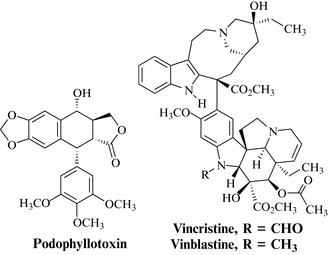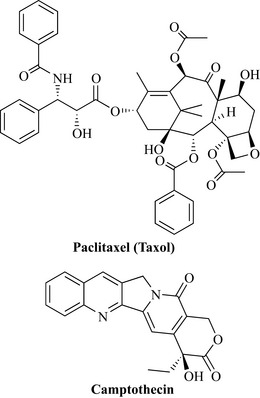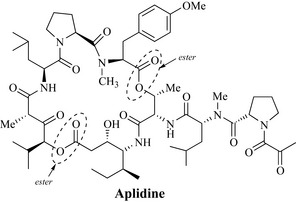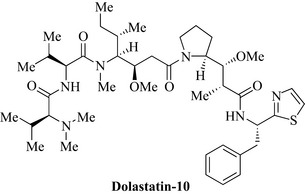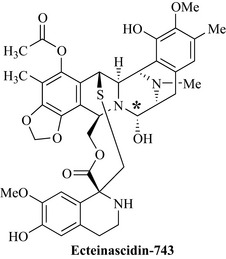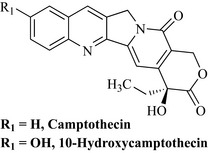Chapter 8 Anticancer natural products
Plants have been the basis of sophisticated medical systems for thousands of years, particularly in China and India, and they have an essential role in health care. The World Health Organization has estimated that 80% of the Earth’s inhabitants rely on traditional medicines for primary health care, and plant products are highly important in the remaining 20% of the population (Farnsworth et al 1985). During the period 1959–1980 approximately 25% of US prescription medicines contained plant extracts, plant constituents or agents that were derived from natural sources. Over 119 chemicals from 90 plants species are important drugs in many countries and three-quarters of these were derived from studying the chemistry of traditional medicines (Farnsworth et al 1985).
The National Cancer Institute
The National Cancer Institute (NCI) was established in the USA in 1937 ‘to provide for, foster and aid in coordinating research related to cancer’. This organization has been involved in many of the great discoveries in fundamental research of cancer and particularly in the characterization of cytotoxic natural products. During the 1950s it was realized that there was a need for screening of natural extracts in a discovery programme and the Cancer Chemotherapy National Service Center was set up (Cragg et al 1993). The objectives of this organization were to procure compounds and to screen and evaluate them in a preclinical and, finally, full clinical setting. This service developed into the modern organization known as the Developmental Therapeutics Program (DTP).
Early successes to exploit plants as a source of anticancer agents included the characterization of podophyllotoxin-type lignans from Podophyllum peltatum, and their semi-synthetic derivatives, and vincristine and vinblastine from Catharanthus roseus (Fig. 8.1). These discoveries drove further interest in plants at the NCI, and collections of plant material were expanded to include 60 countries. This collection strategy was quite extensive and, between 1960 and 1982, 114,000 extracts from 35,000 plants species were screened against a number of tumour types (Cragg et al 1993).
Bioassay-guided fractionation of active extracts led to the characterization of a large number of agents from many different natural product classes. Arguably the most significant discovery from the NCI screening programme was named taxol, from Taxus brevifolia (Taxaceae) (Fig. 8.2). The compound had been previously isolated in 1971 by Wall and co-workers and its activity against a melanoma cell line and in the human xenograft model led to its selection for preclinical development in 1977. Initially, there were problems in acquiring large amounts of the compound, but solutions to these problems and the report of its unique mode of action by promotion of tubulin polymerization and stabilization of microtubules against depolymerization increased interest. Taxol (now known as paclitaxel; see below) has excellent activity against ovarian and breast cancers and was approved in the USA by the FDA in 1993.
Another agent of note, again from the group of Wall, is camptothecin from the Chinese ornamental tree, Camptotheca acuminata (Nyssaceae) (Fig. 8.2). Chinese clinical trials were conducted on this agent, which showed promise against a number of different cancer types, including gastric, liver, head, neck and bladder cancers. However, US clinical trials of the sodium salt were terminated due to a limited number of responses. There has been much work on this class of natural product, with two companies (SmithKline Beecham and Daiichi) having developed and released two products: topotecan and irinotecan.
Between 1985 and 1990 the NCI developed a new in vitro screen that uses 60 human cell lines from nine cancer types representing leukaemia, lung, colon, central nervous system (CNS), melanoma, ovarian, renal, prostate and breast cancers. Synthetic or natural products are made up at concentrations ranging from 10–4 M to 10–8 M and then tested against the 60 different tumour cell lines. The data that are acquired from this test system are evaluated to decide if further investigation is warranted (Alley et al 1988, Grever et al 1992).
• GI50: the concentration at which growth is inhibited by 50%
• TGI: the concentration at which cell growth is totally inhibited
• LC50: the concentration at which 50% of the cells are killed.
The importance of these three factors is that a fingerprint of a compound’s anticancer activity is generated which can be correlated, using a mathematical model, with test results for known anticancer drugs (Paull et al 1989). This can even give an idea of whether a compound works by a similar mechanism of action as a known anticancer agent such as vincristine. Promising compounds with interesting selective profiles of activity (e.g. activity against one particular cell line) are then retested to confirm the reproducibility of these results. In 1995 a three cell line prescreen was introduced to increase the throughput of compounds whilst not reducing the number of compounds with activity in the 60 cell line assay. These cell lines were from lung, CNS and breast tumour types.
A new acquisition programme was initiated in 1986 with contracts for the cultivation and extraction of fungi and bacteria and the collection of marine organisms and terrestrial plants (Cragg et al 1997). Marine organisms were collected from many diverse locations, including the Caribbean, Australasia, Central and South Pacific, Indian Ocean and Polynesia. Plant material was collected in over 25 countries in the tropical and subtropical regions by specialist organizations with botanical expertise such as the Missouri Botanical Garden, the University of Chicago and the New York Botanical Garden.
Collaborations with the NCI rely on working closely with qualified organizations (e.g. universities, research institutes, botanical gardens) in the source country that has access to the biological diversity. Botanists and biologists from source countries collaborate in collections, which are invaluable to the NCI, and in many cases training is provided and workshops are organized for local personnel so that there is a transfer of expertise in certain areas. The source countries send biomass back to the National Products Repository in Frederick, Maryland. In the past, invitations have been made to local scientists of source countries to visit the NCI for collaborative research in natural products (Cragg et al 1997). This fosters openness and true collaboration between the NCI and source country.
For biomass collection, dried plant material (usually in the dry weight range of 0.3–1.0 kg) and frozen marine organism samples (1 kg) are shipped to Frederick and stored at –20°C, lessening the possibility of sample degradation. Biomass is extracted with methanol/dichloromethane (1:1) and then water to give organic and aqueous extracts which are given NCI numbers and stored at –20°C until required for screening (Cragg et al 1997). The extracts are then tested in the in vitro human cancer cell line screen and active extracts undergo bioassay-guided fractionation to isolate pure natural products. Structure elucidation is carried out using NMR and mass spectrometry. Compounds demonstrating significant antitumour activity are selected for secondary testing in in vivo systems and those with good activity advance to preclinical and, finally, clinical development. During this process there is the opportunity to license compounds out to companies for development; this is the preferred route due to the large costs of conducting the development process.
Importantly, agreements ensure that any royalties that may arise are shared with the country of origin and, as previously mentioned with the Convention on Biodiversity, it is a legal requirement that the collection of organisms is only possible with the ‘prior informed consent’ of the authorities of the source country (see Chapter 5, p. 55).
A full review of antitumour agents is beyond the scope of this text but we will briefly cover the three main sources of anticancer agents (marine sources, plants and microbes), giving selected examples of agents and their sources. The reader is urged to consult the excellent reviews by Cragg and co-workers on this subject (Cragg & Newman 1999, 2000, Cragg et al 1993, 1997).
Marine anticancer natural products
Marine organisms have no history of medicinal use but, because the oceans cover 70% of the Earth’s surface, there is a vast reserve for the discovery of new natural product drugs. This huge environment is home to a fantastic range of diverse organisms and, of the 28 major animal classes, 26 exist in aquatic areas and eight are exclusively aquatic (Cragg et al 1997). Collection of biomass is usually carried out by diving and in some cases submersibles can give access to organisms that occur in deeper sites, although this is a highly expensive procedure.
The discipline of marine natural product chemistry is comparatively new compared to phytochemistry, with relatively small numbers of natural products having been reported. At present there is one marine natural product which is used as an anticancer drug clinically (Ecteinascidin 743, Yondelis), and a number are in clinical trials and their potent activities highlight the future importance of this source. A compound in development worth noting is bryostatin-1, which is a novel macrocyclic lactone derived from the marine bryozoan, Bugula neritina. This compound modulates protein kinase C activity and phase I studies have demonstrated activity against several tumour types. Bryostatin-1 has subsequently been investigated extensively in phase II clinical trials as a single agent and data suggest that it may have potential in combination with other cytotoxic agents. Didemnin B (Trididemnum solidum) was the first marine natural product to enter clinical trials and has recently been shown to induce apoptosis (programmed cell death) in a wide range of cell lines. Aplidine (Fig. 8.3) or dehydrodidemnin B, which is structurally related to didemnin B, is a marine depsipeptide obtained from the tunicate Aplidium albicans, originally found in the Mediterranean. Tunicates, which are also known as sea squirts, are organisms that attach themselves to submerged objects and feed by removing microscopic organisms from the water that is drawn through them. Depsipeptides are cyclic peptides that also possess a cyclic ester functional group. Aplidine blocks the cell division cycle in human tumour cell lines and prevents the onset of DNA synthesis. Like didemnin B, it has also been shown to be an inducer of apoptosis in many cell systems. Additionally, using the xenograft assay, grafted into athymic mice, aplidine demonstrated considerable activity against colon, bladder, lung, prostate and stomach tumours, and against melanoma and lymphoma tumours. This agent is currently in clinical trials. Aplidine demonstrates some of the very best features of a natural product, being highly chiral and exhibiting great functionality. Both of these features contribute to the high cytotoxicity of this molecule, which in nature is probably produced by Aplidium species as a chemical defence mechanism.
One of the most promising groups of agents comes from the sea hare (Dolabella auricularia), an herbivorous mollusc from the Indian Ocean which produces cytotoxic linear peptides. An interesting member of this class is dolastatin-10 (Fig. 8.4), an inhibitor of microtubule assembly, currently in clinical trials.
Perhaps the most interesting antitumour marine compounds and the first anti-cancer drug to come from this marvelous source is ecteinascidin-743, now marketed as Yondelis (Trabectidin) (Fig. 8.5), from Ecteinascidia turbinata, which is a tunicate found in the Caribbean and Mediterranean. Ecteinascidin-743 has very potent activity against a broad spectrum of tumour types in animal models; it binds to the minor groove of the DNA double helix and inhibits cell proliferation, leading to apoptosis of cancer cells. This binding to the minor groove of DNA allows an alkylation reaction to occur between a guanine residue of the DNA and an electron-deficient carbon on the molecule (* in Fig 8.5).
Plant antitumour agents
Camptotheca acuminata (Nyssaceae)
In 1957, a small number of ethanolic plant extracts (1000) were screened at the Cancer Chemotherapy National Center (USA) and extracts of Camptotheca acuminata were shown to possess high activity. The late Dr Monroe Wall, who will be remembered as a leading expert in plant antitumour agents and a wonderful enthusiast for natural product research, established a natural product research group at Research Triangle Institute which conducted some research that was funded by the NCI. Dr Wall, who was later joined by Dr Mansukh Wani, became interested in the constituents of Camptotheca, particularly due to the high activity of these extracts. Wood and bark (20 kg) were collected for extraction and the extracts were shown to be active against a mouse leukaemia life prolongation assay in which it was unusual to find activity (Wall & Wani 1995). During the 1960s, the bioassay-guided isolation process was slow and it could take as long as 3 months to get bioassay results from the mouse life-prolongation assay back to the chemists working on the extracts (Wall & Wani 1995).
When compared with cellular assays today, in which it may only take a few days to decide if extracts and fractions are active, it is worth noting how diligent, persistent and thorough these researchers were. Extraction of the plant material was carried out first using a non-polar solvent (hot heptane) to remove very non-polar natural products. The plant material was then extracted with ethanol and this extract was treated with chloroform and aqueous ethanol to give two phases, the lipophilic chloroform phase being highly active. Additional extraction of the aqueous phase with chloroform gave a further active chloroform extract. High activity was associated with all of the chloroform extracts of the ethanolic portion, indicating that the active natural product had a degree of lipophilicity. Column chromatography was initially attempted on these active extracts using alumina as the sorbent, but what was not known at the time was that the active component binds very tightly to alumina and could not be eluted from the column. Extensive partitioning of the extract was tried in separating funnels using the quaternary system (four solvents) chloroform/carbon tetrachloride/methanol/water and each of the fractions were assayed in the mouse life-prolongation assay and in vitro cellular cytotoxicity assay. This partitioning system gave excellent separation and active fractions were combined to yield a yellow precipitate, which was subjected to chromatography on silica to which the active agent did not irreversibly bind. Further crystallization of active fractions led to the isolation of the active agent, camptothecin (Fig. 8.6). The structure elucidation of this natural product was carried out by conversion to its chloroacetate, which was then further converted to the iodoacetate salt which gave crystals of sufficient quality for X-ray structural analysis.
Stay updated, free articles. Join our Telegram channel

Full access? Get Clinical Tree


